|
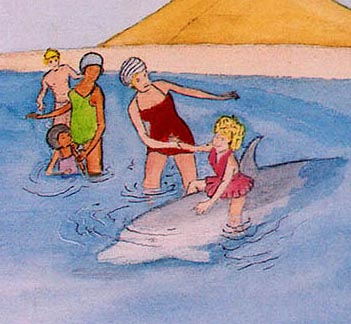
Darby worked
for Delfina & Co. The outfit that put people in the water
with El Fornio's famous dolphins. Here he watches over a group
of mothers and their daughters as they ride the dolphins.
I FORGOT TO MENTION
that on the afternoon Serra’s heart was stolen, as we made
our way through the throngs of Old Spanish Day revelers, Janet
and I ran into Darby Hipper.
At first we thought Darby was going to be a likely
accomplice on our journey to the Rusty Pelican, but he was all
business, on his way home after work.
“Just heading back,” he sighed. “Not
really a day I want to stay out. Plus, I’m repainting the
house.” He looked around at the rising mayhem.
“All you do is paint that house,” I told
him.
“Yeah,” he reckoned. “It’s like
the Golden Gate bridge er somethin’—you get to one
end, and it’s time to turn around and start over at the
other.”
Darb worked out of the harbor, for Delfina &
Co., the “Swim with the Dolphins”
tour group, and both Janet and I could see the salt and sun
of a day’s work had worn him out.
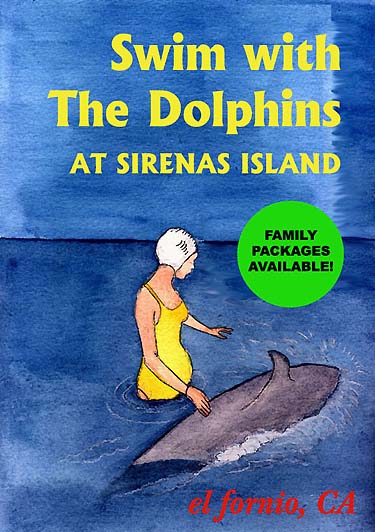
Packages
start at $199. But for $39 you can smell
their fins while you touch their heads.
At twenty-six, looking like a blond-haired Tom Cruise
("great hair without the Scientology," I always said),
Darb was in flip-flops with dirty toes, one bloody and stubbed,
white shorts, worn out red tank top and a Dodgers cap. He had
a black bag slung over his shoulder that he kept adjusting delicately
with two hands supporting the weight at the bottom.
Janet looked him over. “You got something special
in there, Darb?”
He laughed. “Caught me, eh? Check it out.”
Darb took the bag off his shoulder and put it on the ground.
“It washed up the other day.”
He took down the sides and lifted up a tall, two-gallon
jar. Inside a small, hairless animal floated in formaldehyde,
its short nose against the glass and tail curved slightly to
fit in the space. “Targuman found it on the beach near
White Hills yesterday.”
“Of course Targuman did,” I came back.
“He finds all the weird bric a brac.”
“Is it a baby dolphin?” Janet asked.
“A fetus,” Darb nodded. “I think
it’s perfect. Not a mark. It could be the offspring of
a mother killed by locals. Or I’m also thinking a swordfish
might have done her in. They’re starting to run. I
don’t think it’s any of our dolphins.”
I bent over and looked closer at the creature in
the jar. “So this goes right into your collection? Just
like this?”
“Who’s asking? You—or the lawyer?”
“I’m askin’,” Janet said. “Not
the lawyer.”
“Yeah. Into the colleción,” Darb
said, dropping into Spanish. He put the jar back in the bag
and hoisted it over his shoulder, sloshing. “It’s
a keeper, for sure.”
And Darby had quite a collection. Local snakes,
fish, rays, an El Fornio iguana, embryos of vertebrates and
invertebrates—even the heart of a convicted criminal he
had picked up on Ebay—all were nicely held in jars of preservatives
with notations and sourcing. He made no bones about his collecting
hobby, and let anyone come and see the shelves he kept neatly
dusted and tidy. Some had names, as if they were pets, like
“Henry the Green Rock Crab” or Dahlila who was a moray
eel he had bought one day off of a fisherman.
The afternoon he brought her home, Darby wrestled
the muscular beast into a pillowcase, still alive, before convincing
it of its new quarters
Dahlia wasn’t a random name.
The story goes that as Darby forced the moray into
the jar from the sack, Tom Jones was working his way through
a tune on the radio. The sight of the moray in the glass was
encoded with the hook of the jingle and every time he looked
at the eel peering back at him, the song would play in his head.
“That’s Dahlila,” he would say to people, and
the name stuck. “Like the Tom Jones song.”
Janet loved that kind of thing. “One more for
the shelf,” she laughed. And off we were to the Rusty,
leaving Darby as a party mate for another day, which was too
bad. We both liked Darby a lot.
Darby Hipper hadn’t seen either of his parents
for some time. His father had been out of sight since Darb was
six, having garnered permanent residence in Columbia due to
certain commercial ambitions he had developed with the coca
leaf. After the father’s incarceration, his mother, Janis,
brought the boy back from Los Angeles to live with her in El
Fornio.
Janis was fifth generation El Fornio and part of
the graduating class with Elihu Targuman. She remembered Eli
years afterwards, “He was so normal, chess club and the
total dork that would ask you out. And then all of a sudden,
his outsides were the same, but his insides had changed.”
Darby and Janis lived with her parents at the family
house, the sixth lot down at 257 Sardonxy Way. Her older brother
Robert had disappeared years before after a falling out with
their father, Robert, Sr. In 1976, a family friend on a visit
to Spain claimed to have seen Robert, Jr. in the Alhambra.
“He always thought that the Gypies were the
real people of the world,” Janis recounted. “And,
sure, fine. But,” flicking the ash from her cigarette.
“Maybe the Gypsies are something special, but if you aren’t
a real Gypsy, why fake it?”
Her parents lasted another two years, dying just
a month apart. Janis got the house, which had long since been
paid for, and kept her and Darby ankle deep in tuna helper and
quesadillas by working for the Rusty Pelican.

The Rusty
Pelican has been a bar, tavern and restaurant in El Fornio since
1876.
They are known for their Mahi Mahi burgers, Bloody Marys and
great bands.
She
was a pretty good waitress, in a small town way, BLTs, grilled
cheese, tomato soup, local fish specials. She did breakfasts
and lunches, got off work and joined other locals in the business
for a drink at work, then two or three down at the Leathercoat.
Another at the Hungry Tiger, then Safeway where she would pick
up a gallon of Inglenook.
By this time Janis was smoking about a pack of cigarettes
a day (Cool, menthols), eating a spot here and there and putting
away a fair amount of Malibu and diet coke. She had lost a couple
of teeth, but they were molars so no one noticed and what had
been at one time a sweet beach girl figure was becoming more
wiry by the season. After Darb’s father, Janis hooked up
occasionally with one man or another, but they sensed the weakness
in her or lingered to take advantage of it.
Sometimes she wouldn’t come home at all, but
that was much later and Darb would check her room every morning
before he went off to school. He knew he could find Janis at
any number of places along the wharf if he spent the time to
look for her.
“Have you seen Mom? Is she in there?”
Darb would skateboard from joint to joint looking after her.
By
Darby’s freshman year, Janis was hitting forty and life
was catching up. She didn’t work full-time and when she
did shifts could fall apart depending upon how liver weary she
was. Her focus was waning. Darb always thought it was the loss
of one of her front teeth, the right incisor, that was the beginning
of the end.
“Hey,” she said one late morning, sitting
at the kitchen counter, having a smoke and a diet coke. “Look
at that,” pointing to a picture in an article in the Sunday
paper. One of Dorothea Lange’s dustbowl women was resting
her face on a wispy hand. Janis laughed, “I made the paper!”
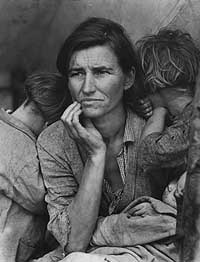
“One
of Dorothea Lange’s dustbowl women
was
resting her face on a wispy hand.
Janis laughed, “I made the paper!”
Then she would rearrange her collection of abalone
shells and driftwood on the kitchen windowsill thinking that
it would bring good luck. “There,” after fifteen minutes
of moving mother-of-pearl and salty wood around, she’d
say, “It’ll be a great week!”
Darby finally went down to city hall one afternoon
and got the forms for Janis to fill out. By going on disability,
with a son who was still a minor, she qualified for a workable
monthly stipend. Darby picked up slack by working for Ed and
Abby Goodman at Mission Petrol with additional shifts at Hang
Dog, the surf shop on the wharf.
At the end of the summer, at the Fiesta parade,
weeks from Darby’s sophomore year, Janis died face down
next to a Bear flag plastic cup, one flip-flop on, one flip-flop
thirty feet from where she had been found in the early morning
by Targuman and the clean-up crew. It was Janet and myself—with
Targuman muttering on the periphery—who told Darby the
news, and he took it pretty well. He knew that his mother had
been suffering and that the life other people had was never
going to be the life she had.
“Janis could have never had another drink,”
Darby knew, “And anyone who met her would still know something
was up.”
To her credit, Janis made it look like a kind of
happiness. “She was the queen of happy hour!” a buddy
from the Rusty crooned at her wake.
“Water,” Darby told Janet the day of the
funeral. “My mom never drank enough water. She heard it
was dirty around here. Best to get your liquids somewhere else.”
“Like the Rusty?” Janet said.
“At least you get your iron,” he followed.
“Janis probably just laid down like she always did. I found
her a few times when I was on my way to work or school. She’d
be asleep right where she was from the night before. I’d
give her money and sit her back up,” he recounted. “That’s
just the way it is. I don’t want anybody thinking it could’ve
been another way. That’s who my mom was. That’s who
my parents were.”
Darby accepted peoples’ foibles and near triumphs.
When he had learned that Targuman was an El Fornio High Moor
alumni, he was immediately accommodating. “Yeah, then he’s
got to know something, right? He’s got to be more than
just a nut, huh?” Darby scratched.
To the average tourist, even fellow citizen, Darby
Hipper seemed like the amiable surfer, which he was, but he
was also a hard working, unsentimental type, keeping the house
he had inherited in total order.
After Janis’ death, he and
Sean the Pelican man repainted the inside and outside completely
white with a slight washed yellow trim and dash of light blue
in the corners. With jobs cobbled together, Darb paid the property
tax and utilities himself—on time and often two months
ahead so that he could concentrate on being in the water.
Janet knew the reason. “He’s a Virgo,”
she’d tell anyone listening. One day she pointed to his
swim trunks. “Just look. His favorite color—white.”
Because he knew the dolphins as much as anyone in
the area, Darb began working for Delfina & Co. the “Swim
With the Dolphins” outfit that had contracted with the
city and county to bring visitors into the bay whose interest
was getting in the water with El Fornio’s famous dolphins.
Darby became a Master Guide by the time he was eighteen, a year
after graduating high school. Through Janet, he became a member
of the Sirenas Island Channel Keepers, the legal arm that defended
the bay against polluters, taking water samples and propping
binoculars up on the cliffs to look for ships and sailors expelling
their shitty ballast wherever they seemed fit.
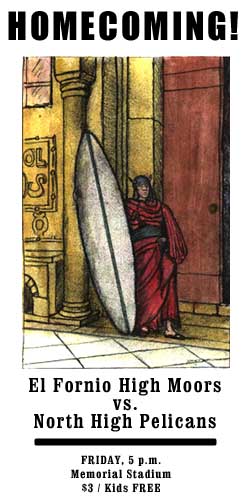
The poster
for the Moors and Pelicans
homecoming game the year of the big fire.
After Mission Petrol burned down and blew ski high
during what became known as the “Moor
Homecoming Fire,” Darby went full-time with Delfina
& Co. It was a thrill for him putting people in the water
with the animals. But there were the occasional mishaps.
Most people thought of the dolphins as peaceable
animals, and they were—mostly. But last year, a notable
Los Angeles debutante, the daughter of a film producer, came
up for spa treatments, including swimming with the dolphins.
Unfortunately, she lied on the spec sheet about her menses so
when she was put in the water, some of the creatures went wild,
pulling her under, teething her arms and legs, a quick pass
of the teat and thump of a fin against her head. By the time
Darby dragged her out of the sea onto a waiting Zodiac,
the visitor from Beverly Hills was bleeding and crying.
Darby and his crew set her up on shore with the
responding paramedics, one of whom happened to be a local named
Virginia Jefferson. Vee claimed to be the great, great, great
grand daughter of Thomas Jefferson and Sally Hemings. “Come
on!” she said to unbelievers. “I’ll take the
DNA test any time!”
Paramedic Jefferson treated the woman as local kids
and tourists watched the patient, half in shock, seated on a
turned over wooden Aliso-Kennedy
tomatillo crate, wetsuit down to her waist. Vee dabbed the
bite marks with cotton swabs. The patient held an arm up, head
tilted. The gathering crowd gazed upon her in a scene worthy
of Jean-Leon Gerome.
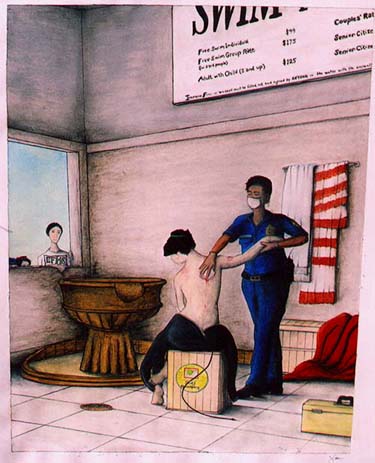
“Paramedic
Jefferson dabbed the bite marks
with cotton swabs. The patient held an
arm up, head tilted as the gathering
crowd gazed upon her . . .”
“That’s
a reality sandwich,” I turned to Darby.
“They’re beautiful animals, but they can
be demons,” Darby replied. “You doing water work down
here for Janet?”
Darb noticed that I held two vials of fluid in my
hand as we walked back up the beach. “Yep, she’s around
here somewhere. We’re supposed to meet up.” I looked
at Darb. “Don’t you have to, you know . . .”
I tilted back at the crowd with the producer’s daughter.
Darb stopped. “Yeah,” he turned. “Reality
bites the sandwich. They’ll expect me to help with the
report. Lame. It always is. It’ll involve the cops, the
county, the city, the owners of Delfina. Everytime something
like this happens someone makes a big deal out of it.”
Darby squinted, looking out over the water. “Maybe the
woman was just a total bitch and the dolphins didn’t like
her. Doesn’t anybody ever consider that?”
|










